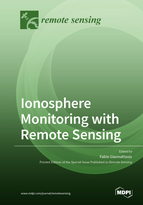Ionosphere Monitoring with Remote Sensing
A special issue of Remote Sensing (ISSN 2072-4292). This special issue belongs to the section "Atmospheric Remote Sensing".
Deadline for manuscript submissions: closed (31 August 2022) | Viewed by 13107
Special Issue Editor
Interests: space weather; magnetosphere–ionosphere coupling; ionospheric turbulence; complex systems; solar physics
Special Issues, Collections and Topics in MDPI journals
Special Issue Information
Dear Colleagues,
Understanding the processes occurring in the Earth’s ionosphere is of utmost importance to characterise several phenomena relevant for Space Weather. In fact, the ionospheric plasma promptly reacts to variations of magnetic and electric fields and, thus, is particularly sensitive to different processes on a wide range of spatial and temporal scales. These variations may substantially affect, for instance, the physical properties of the ionosphere, its energetic balance, and the propagation of electromagnetic signals throughout the ionospheric layers.
Nowadays, thanks to the increased volume of high-quality data, these features can be reliably investigated due to the joint effort of remote sensing and in-situ facilities, such as ionosondes, radars, satellites, and GNSS receivers. This Special Issue aims to encourage advances in our knowledge of the ionosphere through the use of complementary data with different origins and their comparison with models.
In this context, contributions that address but are not restricted to the following topics are welcome:
- The impact of sunlit, solar and geomagnetic activity on the ionosphere at all latitudes;
- The impact of ionospheric variations on technology;
- Improvements and new constraints of ionospheric models through new observations, analyses and techniques;
- Investigating the magnetosphere–ionosphere coupling through different multi-instrumental approaches;
- New instruments, missions and tools to monitor the ionosphere.
Dr. Fabio Giannattasio
Guest Editor
Manuscript Submission Information
Manuscripts should be submitted online at www.mdpi.com by registering and logging in to this website. Once you are registered, click here to go to the submission form. Manuscripts can be submitted until the deadline. All submissions that pass pre-check are peer-reviewed. Accepted papers will be published continuously in the journal (as soon as accepted) and will be listed together on the special issue website. Research articles, review articles as well as short communications are invited. For planned papers, a title and short abstract (about 100 words) can be sent to the Editorial Office for announcement on this website.
Submitted manuscripts should not have been published previously, nor be under consideration for publication elsewhere (except conference proceedings papers). All manuscripts are thoroughly refereed through a single-blind peer-review process. A guide for authors and other relevant information for submission of manuscripts is available on the Instructions for Authors page. Remote Sensing is an international peer-reviewed open access semimonthly journal published by MDPI.
Please visit the Instructions for Authors page before submitting a manuscript. The Article Processing Charge (APC) for publication in this open access journal is 2700 CHF (Swiss Francs). Submitted papers should be well formatted and use good English. Authors may use MDPI's English editing service prior to publication or during author revisions.
Keywords
- Space weather
- Magnetosphere–ionosphere coupling
- Ionosphere observations
- Ionospheric models
- GNSS
- Radio occultation
- Ionosonde
- Radar
- Satellites






